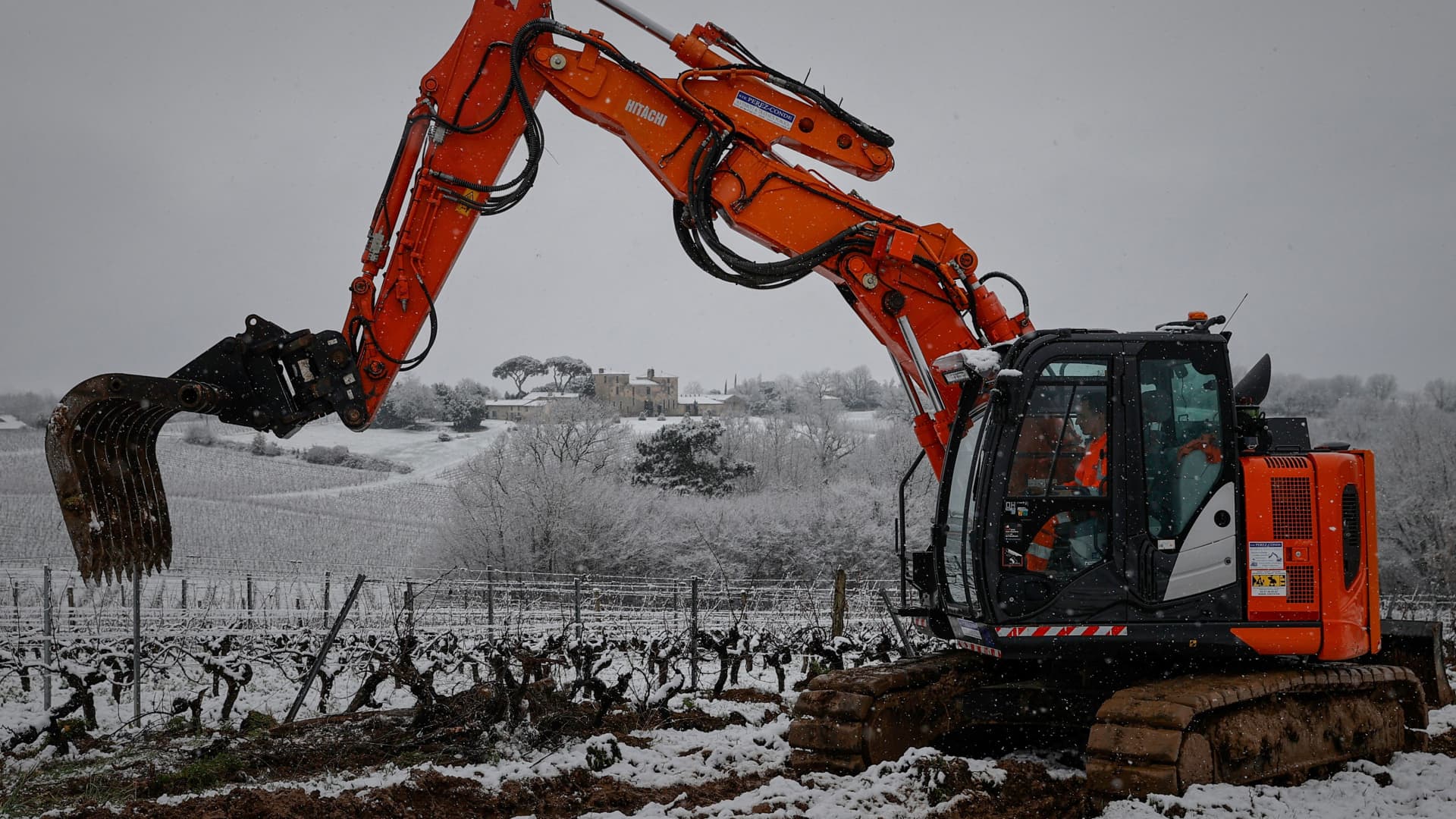A worker uses a backhoe to grub up an area of vines during snow fall in a vineyard in Haux, some 25 kms southeast of Bordeaux, southwestern France, on January 18, 2023.
Romain Perrocheau | Afp | Getty Images
“It’s become very difficult.”
Those words from a wine producer in Bordeaux underscore the huge challenge facing the famous French region as it undergoes a massive transformation.
Extreme weather and changing consumer habits are hitting winemakers in a way that no longer makes it viable for some to keep their wineries open. Instead, some are uprooting vines and seeking government compensation.
“In the next five years, we will see less vines in Bordeaux,” Sylvie Courselle, an agricultural engineer and enologist at Château Thieuley, told CNBC.
According to data from the local authorities, between early June and July this year there were 584 requests for compensation from winemakers that want to either completely end their production or diversify the use of their land. In total, this corresponds to almost 5,000 hectares of vineyard area that could be about to change. Producers had only until mid-July to ask for support.
“Climate change can accelerate this,” Courselle told CNBC, adding that in recent years winemakers have had to deal with hailstorms, frosts and droughts that significantly impact the crop.
She thinks that, going forward, the biggest challenge will be access to water — one of the most essential ingredients in wine production.
A grape picker harvests red grapes in southwestern France.
Thibaud Moritz | Afp | Getty Images
But the challenges go beyond climate change. Historically, there’s been a focus on the production of red wine in Bordeaux, but consumers are increasingly opting for beer and lighter wines. Evidence of this is the boom in the number of active brewers in France. These have grown from 322 in 2009 to 2,500 in 2021, according to data from Statista.
In addition, data from the French institute OFDT shows that wine sales dropped by more than a third between 2000 and 2020. Over the same period, there was an increase of 7% for beer sales.
France is also selling a little less wine abroad. The European nation dominates the trade of wine worldwide, alongside Spain and Italy. But in 2022, France saw exports drop 5% versus the previous year, according to the International Organisation of Vine and Wine.
German wines growing
Bad news in one place can become good news elsewhere. Ernst Büscher, a press officer at the German Wine Institute (DWI), told CNBC that German wines are experiencing a very different trend.
“We’re quite happy,” he said. “Up until now, for German wines, the advantage of higher temperatures are bigger than the negative sides of extreme weather,” he added.
Vineyards in northern Germany have also had to deal with episodes of frost — which makes it harder for buds and young shoots to mature — but the region has also had warmer temperatures. Büscher said that the current temperatures of roughly 35-36 degrees Celsius is unusual by historical standards.
According to the International Organisation of Vine and Wine, Germany was the only EU country that reported an increase in wine production last year. In total, production jumped 6% from the previous year “due to the dry and hot growing season which has been beneficial for vineyards.”
The U.K. is also finding itself in a similar position to Germany. Hectares with vines have more than quadrupled since 2000, according to WineGB. In 2021, wine sales rose by 31% annually to 9.3 million bottles. The majority of them being sparkling rather than still wine.
Wine production volume in the U.K. skyrocketed in 2018, data from Statista shows. Though levels have come down since, they are still well above the production figures registered prior to that year.
This photograph taken on December 18, 2022, shows frost-covered vines near Villers-Allerand, northeastern France.
Francois Nascimbeni | Afp | Getty Images

